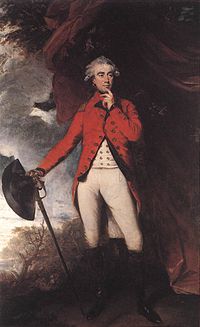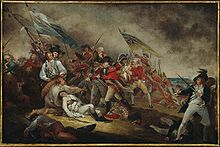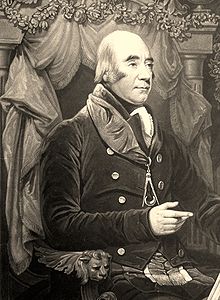- Francis Rawdon-Hastings, 1st Marquess of Hastings
-
The Marquess of Hastings
KG PC
Governor-General of the Presidency of Fort William In office
4 October 1813 – 9 January 1823Monarch George III
George IVPrime Minister The Earl of Liverpool Preceded by The Lord Minto Succeeded by John Adam
As Acting Governor-GeneralGovernor of Malta In office
22 March 1824 – 28 November 1826Monarch George IV Prime Minister The Earl of Liverpool Preceded by Hon. Thomas Maitland Succeeded by Alexander George Woodford
As Acting GovernorPersonal details Born 9 December 1754
County Down, Kingdom of IrelandDied 28 November 1826 (aged 71)
At sea off NaplesNationality British Spouse(s) Flora Campbell,
6th Countess of Loudoun
(1780–1840)Military service Allegiance  Kingdom of Great Britain
Kingdom of Great BritainService/branch British Army Rank Major-General Commands Commander-in-Chief of India Battles/wars American War of Independence
French Revolutionary WarsFrancis Edward Rawdon-Hastings, 1st Marquess of Hastings KG PC (9 December 1754 – 28 November 1826), styled The Honourable Francis Rawdon from birth until 1762 and as The Lord Rawdon between 1762 and 1783 and known as The Earl of Moira between 1793 and 1816, was an Irish-British politician and military officer who served as Governor-General of India from 1813 to 1823. He took the additional surname 'Hastings' in 1790 in compliance with the will of his maternal uncle, Francis Hastings, 10th Earl of Huntingdon.[1]
Contents
Background, education and early military career
-
Marquess of Hastings by Hugh Douglas Hamilton (c.1801)
-
Marquess of Hastings, Governor-General of India by Joshua Reynolds (c.1812)
Hastings was born at Moira, County Down, the son of John Rawdon, 1st Earl of Moira and Elizabeth Rawdon, 13th Baroness Hastings. He grew up there, and in Dublin, Ireland.[2] He joined the British Army on 7 August 1771 as an ensign in the 15th Foot, (the going rate was ₤200). He was at Harrow School and matriculated at University College, Oxford,[1] but dropped out. He became friends there with Banastre Tarleton. With his uncle Lord Huntington, he went on the Grand Tour[3] On 20 October 1773, he was promoted to lieutenant in the 5th Foot. He returned to England, to join his regiment, and sailed for America on 7 May 1774.
In May 1789 he acted as the Duke of Yorks second in his duel with Lieut.-Colonel Lennox on Wimbledon Common.[1]
American War of Independence
Battle of Bunker Hill
Rawdon was posted at Boston as a Lieutenant in the 5th Regiment of Foot's Grenadier company, during the Battle of Lexington and Concord, but he saw action at the battle of Bunker Hill. Serving with the grenadiers, he participated in the second assault against Breed's hill (which failed), and the third assault against the redoubt. As his superior, Captain Harris, was wounded beside him, he took command of his company, for the successful assault.[4] John Burgoyne noted in dispatches: "Lord Rawdon has this day stamped his fame for life." He also was wounded during the assault.[1] He was promoted Captain, and given a company in the 63rd Foot. There was a rumor that Lieutenant Lord Rawdon killed the rebel General Joseph Warren. Lord Rawdon is depicted in John Trumbull's famous painting The Death of General Warren at the Battle of Bunker Hill. Rawdon is in the far background holding the British ensign,.
Winter quarters 1774–1775
During the Boston winter quarters, Rawdon made his stage debut, delivering a prologue for Aaron Hill's tragedy, Zara, which had been written by John Burgoyne.[5] He was appointed Aide-de-camp to General Sir Henry Clinton, and sailed with him on the expedition to Brunswick Town, North Carolina, on the Cape Fear River, and then to the repulse at Fort Moultrie, Charleston, South Carolina. He returned with him to New York. On 4 August, he dined with General Clinton, Admiral Lord Howe, Lord Cornwallis, General Vaughan, and others.[6] During the Battle of Long Island, he was at headquarters, with Clinton.
Landing at Kip's Bay
On 15 September, he led his men at Kip's Bay, an amphibious landing on Manhattan island.[7] The next day, he led his troops in support of the Light Infantry, that attacked Harlem Heights, until the Americans withdrew.
White Plains
Again he participated at the landings at Pell's Point. The British pressed the Americans to White Plains, where on 1 November the Americans withdrew from their entrenchments.
Rhode Island, England, and New York
On 8 December he landed with Clinton at Rhode Island securing the ports for the British Navy. On 13 January 1777, with Clinton, he departed for London, arriving 1 March. During a ball at Lord George Germain's he met Lafayette, (who was visiting London).[8]
Returning to America, in July, while Howe went to his Philadelphia campaign, Rawdon went with Clinton to the New York headquarters, where he participated in the battles of the New York Highlands, where on 7 October, Fort Constitution, (opposite West Point), was captured. However, this was too late to link up with General Burgoyne at Albany.[9]
Rawdon was sent to Philadelphia with dispatches, and returned to New York for the winter, where he raised a regiment, called the Volunteers of Ireland, recruited from deserters and Irish loyalists. Promoted colonel, in command of this regiment, Rawdon went with Clinton to Philadelphia.[10] Starting out on 18 June 1778, he went with Clinton during the withdrawal from Philadelphia to New York, and saw action at the Battle of Monmouth.[11] He was appointed adjutant general. Rawdon was sent to learn news of the battle of Rhode Island.[12]
At New York, on 3 September 1779, he quarreled with Clinton, and resigned his position as adjutant general.[13] He served with the Volunteers of Ireland, during the raid on Staten Island, by Lord Stirling on 15 January 1780.[14]
Southern Campaign
He went south to the Siege of Charleston with reinforcements, then Lord Cornwallis posted him at Camden (16 August 1780)[1] as the British sought to occupy South Carolina. Rawdon commanded the British left wing at the Battle of Camden. When Cornwallis went into Virginia, he left Rawdon in effective command in the south.
Perhaps his most noted achievement was the victory in 1781 at the Battle of Hobkirk's Hill, where in command of only a small force, he defeated by superior military skill and determination, a much larger body of Americans rebels. Thinking, (in error) that Nathanael Greene had moved his artillery away, Rawdon attacked Greene's left wing, forcing the Americans to retire.[15]
However, Rawdon was forced to begin a gradual retreat to Charleston, relieving the siege of Ninety-Six, but then evacuating it and withdrawing to Charleston. When the Loyalists he saved in the Siege of Ninety-Six were eventually relocated to Nova Scotia, they named their community of Rawdon, Nova Scotia after him. In July 1781, in poor health, he gave up his command. He was captured at sea, by De Grasse, but was exchanged.[16] He was awarded the freedom of the city of Dublin in recognition of his service in America.[17] After Rawdon's departure the decision was made to evacuate Charleston as the war drew to a close.
French Revolutionary Wars
See also: French Revolutionary Wars: Campaigns of 1794Following the declaration of war, of France upon Great Britain, he was appointed major general, on 12 October 1793. Sent by the Pitt ministry, Hastings launched an expedition into Ostend, France, in 1794.[18][19] He marched to join with the army of the Duke of York, at Alost. The French general Pichegru with superior numbers forced the British back toward their base at Antwerp. He left the expedition, feeling Pitt had broken promises.[20]
== Political career== hi
Rawdon-Hastings sat for Randalstown in the Irish House of Commons from 1781 until 1783, when he was created Baron Rawdon, of Rawdon, in the County of York.[21] In 1787, he became friends with the Prince of Wales, and loaned him many thousands of pounds. In 1788 he became embroiled in the Regency Crisis. In 1789, he took the surname Hastings in accordance with his uncle's will. He succeeded his father as 2nd Earl of Moira on 20 June 1793, and served in the House of Lords for three decades.
Plot to become Prime Minister
In 1797 it was rumoured briefly that he would replace Pitt as Prime Minister. There was some discontent with Pitt over his policies regarding the war with France. Additionally Pitt's long tenure in office had given him ample opportunity to annoy various political grandees, including but not limited to Lords Leeds, Thurlow and Lansdowne.
In mid-May a combination of these various figures, coupled with a handful of Members of Parliament, proposed to make the Earl of Moira Prime Minister. Having fought in the American War and having led an expedition to Quiberon he commanded widespread respect. His closeness to the Prince of Wales also established him as a potential rival to Pitt, who was supported heavily by King George III.[22]
The prime motivation for the plot to become Prime Minister was to secure peace with France, the plotters having come to believe (somewhat unfairly) that Pitt was an obstacle to this objective. However the plot collapsed barely a month later in mid-June because of a lack of support from the political establishment. Additionally when Moira wrote to the King to propose the change of chief ministers his letter was simply ignored by the monarch. Thus the proposal came to nothing.[23]
Later Politics
He was a long-standing advocate of Irish issues, in particular Catholic Emancipation, and at one point was described by the Irish revolutionary Wolfe Tone as "The Irish Lafayette".[24]
Becoming a Whig in politics, he entered government as part of the Ministry of all The Talents in 1806 as Master-General of the Ordnance and Constable of the Tower,[1] but resigned upon the fall of the ministry the next year. Being a close associate of the Prince-Regent, Moira was asked by him to try to form a Whig government after the assassination of Spencer Perceval in 1812 ended that ministry. Both of Moira's attempts to create a governing coalition failed, and the Tories returned to power under the Earl of Liverpool. On 6 December 1816, he was raised to the rank of Marquess of Hastings together with the subsidiary titles Viscount Loudoun and Earl of Rawdon.[25] Fifteen years before Hastings County, Ontario and three of its early townships were named after him.[26]
He also became the patron of Thomas Moore the poet, who had visited him at Donington Park, writing that I thought it all exceedingly fine and grand, but most uncomfortable.[27] Moore was later disappointed when Moira, having been appointed Governor General of India, did not offer to take him with him to India on his staff and the two men only met again once.[28]
Governor-General of India
Through the influence of the Prince-Regent, Moira was appointed Governor-General of India in 11 November 1812.[29] His tenure as Governor-General was a memorable one, overseeing the victory in the Gurkha War (1814–1816); the final conquest of the Marathas in 1818; and the purchase of the island of Singapore in 1819.
After delays clearing affairs, he reached Madras on 11 September 1813. In October, he settled in at Calcutta. British India then consisted of Madras, Bengal, and Bombay. He commanded an army of 15,000 British regulars, a Bengal army of 27 regiments of native infantry, and eight regiments of cavalry; a Madras army, led by General John Abercrombie of 24 regiments of native infantry, and eight regiments of native cavalry.[30]
Gurkha War
In May 1813, the Gurkhas declared war. Hastings sent four divisions in separate attacks General Bennet Marley with 8,000 men against Katmandu, General John Sullivan Wood with 4,000 men against Butwal, General Sir David Ochterlony with 10,000 men against Amar Singh Thapa, and General Robert Rollo Gillespie, with 3,500 men against Nahan, Srinagar, and Garhwal. Only Ochterlony had some success; Gillespie was killed. After inconclusive negotiations, Hastings reinforced Ochterlony to 20,000 men, who then won the battle of Makwanpur on 28 February. The Gurkhas then sued for peace, under the Sugauli Treaty.[31]
Third Anglo-Maratha War
After raids by Pindaris, in January 1817, Hastings led a force at Hindustan in the North; in the South, the Army of the Deccan, under the command of General Sir Thomas Hislop. The Peshwa was defeated by William Fullarton Elphinstone on the Poona. Appa Sahib, was defeated at the battle of Nagpur. Hislop defeated Holkar at the Battle of Mahidpur.
Diplomacy
He was active diplomatically, protecting weaker Indian states. His domestic policy in India was also largely successful, seeing the repair of the Mughul canal system in Delhi in 1820, as well as educational and administrative reforms. He confirmed the purchase of Singapore, from the Sultan of Jahore, by Sir Stamford Raffles, in January 1819.
He became increasingly estranged from the East India Company's Board of Control — see Company rule in India. He was appointed Governor of Malta in 1824. He died at sea off Naples two years later.
Legacy
The HMS Moira was and the Moira River in Ontario, Canada is named in his honour. He was F.R.S. 1787 and F.S.A. 1793. For 1806-8 he was Grand Master of the Free Masons.[32] The character of Rawdon Crawley in William Makepeace Thackery's novel Vanity Fair is named after him.
Family
On 12 July 1804, he married Flora Campbell, 6th Countess of Loudoun, daughter of Major-General James Mure-Campbell, 5th Earl of Loudoun and Lady Flora Macleod. They had six children:
- Flora Elizabeth Rawdon-Hastings (11 February 1806 – 5 July 1839), died unmarried.
- Hon. Francis George Augustus (1807–1807), died in infancy.
- George Augustus Francis Rawdon-Hastings, 2nd Marquess of Hastings (4 February 1808 – 13 January 1844)
- Sophia Frederica Christina Rawdon-Hastings (1 February 1809 – 28 December 1859), married John Crichton-Stuart, 2nd Marquess of Bute and had issue.
- Selina Constance Rawdon-Hastings (1810 – 8 November 1867), married Charles Henry and has issue
- Adelaide Augusta Lavinia Rawdon-Hastings (25 February 1812 – 6 December 1860), married Sir William Murray, 7th Baronet of Octertyre
The marquess also apparently fathered an illegitimate son George Hunn Nobbs by Jemima Ffrench, although this is likely to be a falsification of Nobbs'.
Death
He died aboard HMS Revenge and following his directions his right hand was cut off and buried with his wife when she died; this wish was complied with, and it now rests clasped with hers in the family vault at Loudoun Kirk.[32]
Donington Park
Inheriting Donington Hall from his uncle, he rebuilt it in Gothic style; Wilkins was the architect. He placed the park at the disposal of the Bourbon Princes upon their exile in England following the French Revolution and is said to have left a signed cheque-book in each bedroom for the occupant to use at their pleasure.[27]
References
- ^ a b c d e f Beevor, p.58
- ^ Nelson, p.21.
- ^ Nelson, p.22.
- ^ Nelson, p.27.
- ^ Nelson, p.32.
- ^ Nelson, p.42.
- ^ Nelcon, p.47.
- ^ Nelson, p.55.
- ^ Nelson, p.56.
- ^ Nelson, p.61.
- ^ Nelson, p.62.
- ^ Nelson, p.65.
- ^ Nelson, p.67.
- ^ Nelson, p.69.
- ^ Nelson, p.95.
- ^ Paul David Nelson (May 7, 2007). Baron Rawdon, Earl of Moira, Marquess of Hastings "Lord Rawdon". www.banastretarleton.org. http://home.golden.net/~marg/bansite/friends/rawdon.html Baron Rawdon, Earl of Moira, Marquess of Hastings. Retrieved 2008-10-26.
- ^ Morley p.286.
- ^ Brown, J. (1851) A History of the Highlands and of the Highland Clans, Vol.IV.
- ^ James, C. (1805) A New and Enlarged Military Dictionary, 2nd ed.
- ^ Nelson, p.121.
- ^ London Gazette: no. 12419. p. 1. 1 March 1783. Retrieved 29 April 2009.
- ^ Hague, William J. (September 2004). William Pitt the Younger: A Biography. HarperCollins. ISBN 978-0007147199. p.407
- ^ Hague p.407
- ^ Kelly p.228
- ^ London Gazette: no. 17198. p. 2314. 7 December 1816. Retrieved 29 April 2009.
- ^ Boyce, Gerald E. (1967). Historic Hastings, Belleville: Hastings County Council.
- ^ a b Beevor, p.60
- ^ Kelly p.226-229
- ^ Nelson, p.148.
- ^ Nelson, p.162.
- ^ Nelson, p164–165.
- ^ a b Beevor, p.59
Sources
 This article incorporates text from a publication now in the public domain: Chisholm, Hugh, ed (1911). Encyclopædia Britannica (11th ed.). Cambridge University Press.
This article incorporates text from a publication now in the public domain: Chisholm, Hugh, ed (1911). Encyclopædia Britannica (11th ed.). Cambridge University Press.- Paul David Nelson (2005). Francis Rawdon-Hastings, Marquess of Hastings: Soldier, Peer of the Realm, Governor-General of India. Madison, N.J.: Fairleigh Dickinson University Press. ISBN 0838640710. http://books.google.com/books?id=zYkVSL_x0BAC. Retrieved 2008-10-26.
- Beevor, R. J. (1931). Hastings of Hastings. Printed for Private Circulation.
- Harrington, Jack (2010), Sir John Malcolm and the Creation of British India, Chs. 4&5., New York: Palgrave Macmillan., ISBN 978-0-230-10885-1
- Kelly, Ronan. Bard of Erin: The Life of Thomas Moore. Penguin Books, 2009.
- Morley, Vincent. Irish opinion and the American Revolution, 1760–83. Cambridge University Press, 2002.
External links
- NNDB - Biography
- Ninety Six National Historic Site
- Baron Rawdon, Earl of Moira, Marquess of Hastings
- Francis, Lord Rawdon - Colonel
- Battle of Hobkirk's Hill
- Rediscovering Hobkirk's Hill
Categories:- 1754 births
- 1826 deaths
- British Army personnel of the American Revolutionary War
- British Commander-in-Chiefs of India
- Governors and Governors-General of Malta
- Governors-General of India
- Irish MPs 1776–1783
- Knights Grand Cross of the Order of the Bath
- Knights Grand Cross of the Royal Guelphic Order
- Knights of the Garter
- Lord-Lieutenants of the Tower Hamlets
- Marquesses in the Peerage of the United Kingdom
- Members of the Parliament of Ireland (pre-1801)
- People from County Down
- People of the Gurkha War
-
Wikimedia Foundation. 2010.





